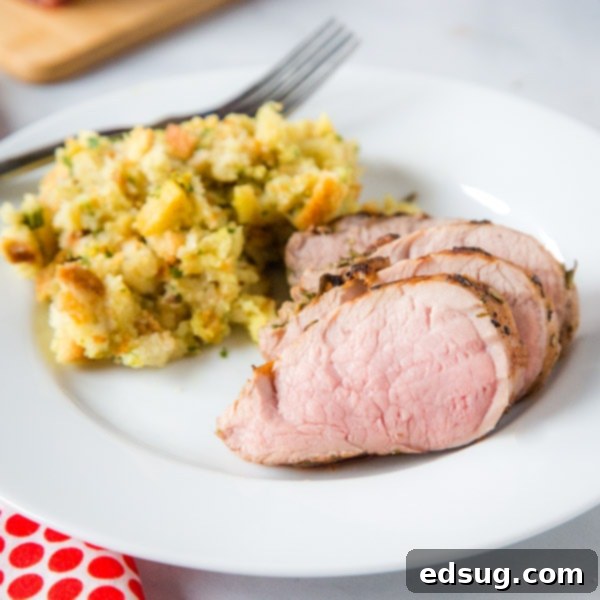Sous Vide Pork Tenderloin: The Ultimate Guide to Perfectly Juicy & Flavorful Results
Pork tenderloin has long been a favorite cut for many home cooks due to its lean nature and quick cooking time. However, it’s also notoriously easy to overcook, leading to dry, tough results. Enter the sous vide method – a culinary game-changer that promises to transform your pork tenderloin into an incredibly tender, consistently juicy, and flavorful masterpiece every single time. If you’ve ever struggled to achieve that perfect tenderness with traditional cooking methods, preparing your pork tenderloin sous vide will forever change the way you cook this fantastic cut of meat.
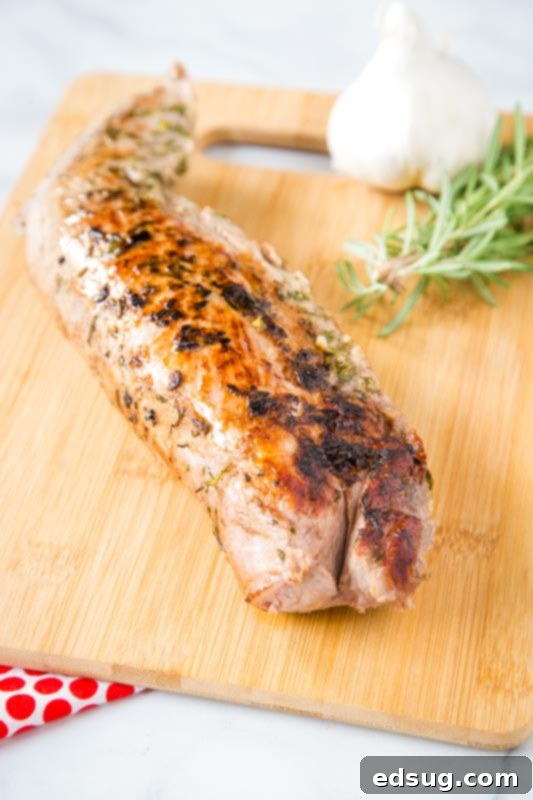
Why Sous Vide Is the Best Way to Cook Pork Tenderloin
The magic of sous vide lies in its precision. By cooking your pork in a temperature-controlled water bath, you eliminate the guesswork and ensure that your meat cooks evenly from edge to edge, never exceeding your desired internal temperature. This gentle, precise cooking method offers several distinct advantages for pork tenderloin:
- Unmatched Tenderness and Juiciness: Pork tenderloin is a lean cut, meaning it has very little fat to keep it moist. Traditional high-heat cooking can quickly dry it out. Sous vide cooks the pork at a steady, lower temperature, allowing the muscle fibers to relax and retain all their natural juices, resulting in an unbelievably tender and succulent texture that melts in your mouth.
- Consistent Results, Every Time: Say goodbye to hockey-puck pork! With sous vide, you set the temperature once, and the circulator maintains it, ensuring your pork is cooked to perfection without any dry spots or undercooked centers. This consistency makes it perfect for dinner parties, holidays, or even busy weeknights when you want reliable deliciousness.
- Enhanced Flavor Infusion: When sealed in a bag with seasonings and marinades, the pork cooks in its own flavorful juices. This creates a powerful flavor infusion that penetrates the meat more effectively than traditional marinating.
- Flexible Timing: While an hour is usually sufficient, you have a generous window of up to four hours for cooking, giving you incredible flexibility. This is especially useful when hosting guests or managing a busy cooking schedule, as you can start it ahead of time without worrying about overcooking.
Understanding the Ideal Pork Temperature: 145º F
The single most crucial factor in achieving tender, juicy pork is cooking it to the right temperature. Whether you’re baking, grilling, pan-searing, or using sous vide, the target internal temperature for pork is 145º F (63º C). Many people mistakenly believe pork needs to be cooked until it’s dry and grey, often leading to tough, unappetizing results. This outdated advice is rooted in past concerns about trichinosis, which is virtually non-existent in modern pork production due to improved farming practices.
The USDA (United States Department of Agriculture) states that pork is safe to eat at 145º F, followed by a three-minute rest. At this temperature, the pork will have a slight blush of pink in the center, indicating optimal juiciness and flavor. Cooking it beyond this point is simply unnecessary and will only lead to a dry, less enjoyable eating experience. Sous vide makes hitting this precise temperature effortless, ensuring your pork tenderloin is never overcooked.
How To Prepare Sous Vide Pork Tenderloin: A Simple Step-by-Step Guide
Preparing pork tenderloin using the sous vide method is incredibly straightforward and yields consistently spectacular results. Here’s how to do it:
- Preheat the Water Bath: Set your sous vide immersion circulator to 145º F (63º C). Allow the water to come to temperature before adding your pork.
- Season the Pork: In a small bowl, combine your chosen seasonings. For a classic flavor, mix together fresh rosemary (finely chopped), minced garlic, salt, and black pepper with a couple of tablespoons of olive oil. Generously rub this mixture all over the pork tenderloin. Don’t be shy with the seasoning; it will infuse beautifully into the meat.
- Seal the Pork in a Bag: Place the seasoned pork tenderloin inside a vacuum-sealable bag. If you have a vacuum sealer, use it to remove all the air and seal the bag securely. If you don’t have a vacuum sealer, you can use a high-quality, zip-top freezer bag. To remove air using the water displacement method, slowly submerge the bag into the water bath, allowing the water pressure to force the air out around the meat. Once almost all the air is out, seal the bag completely just before the top opening goes under water.
- Submerge in Water Bath: Once the water bath reaches the target temperature of 145º F, carefully place the sealed bag of pork into the water. Ensure that the pork is fully submerged. You can use clips to attach the bag to the side of the container or a plate on top of the bag to weigh it down if needed.
- Sous Vide Cook Time: Cook the pork tenderloin for approximately 1 hour. For added flexibility, you can leave it in the water bath for up to 4 hours without negatively impacting its texture or doneness. This extended cooking window is one of the major benefits of sous vide.
- Remove and Pat Dry: Once cooked, carefully remove the pork tenderloin from the bag. It won’t look particularly appetizing at this stage – it will be pale and lack the appealing browned crust. This is completely normal! Use paper towels to thoroughly pat the pork dry on all sides. This step is crucial for achieving a good sear.
- Sear for a Perfect Crust: Heat a large skillet over high heat. Add 1 tablespoon of high smoke point oil (like vegetable or avocado oil) to the pan. You’ll know the oil is hot enough when it starts to shimmer slightly. Carefully place the dried pork tenderloin in the hot pan.
- Achieve the Maillard Reaction: Sear the pork for about 30-45 seconds per side, rotating it to brown all surfaces. You’re looking for a beautiful golden-brown crust. This quick sear adds incredible flavor and texture through the Maillard reaction, making the pork visually appealing and creating a delightful textural contrast.
- Slice and Serve: Remove the pork from the pan, slice it into medallions, and serve immediately. No additional resting time is typically needed after sous vide cooking, as the juices are already evenly distributed throughout the meat.

The Importance of Searing After Sous Vide
While sous vide cooking excels at achieving perfect internal temperature and tenderness, it doesn’t create the browned, flavorful crust that we associate with traditionally cooked meats. This is where searing comes in. After removing your pork tenderloin from the sous vide bath, it will appear pale and somewhat unappetizing. A quick sear in a hot pan (or even on a grill or with a blowtorch) provides that beautiful golden-brown exterior and adds a depth of flavor through the Maillard reaction.
To ensure a fantastic sear, two things are paramount:
- Pat the Meat Dry: Any moisture on the surface of the pork will cause it to steam instead of sear, preventing the formation of a crust. Use plenty of paper towels to dry the tenderloin thoroughly.
- Use High Heat: A screaming hot pan with a high smoke point oil (like avocado, grapeseed, or vegetable oil) is essential. You want to create that crust quickly without cooking the interior of the pork any further.
The contrast between the crispy, flavorful exterior and the uniformly tender, juicy interior is what makes sous vide pork tenderloin truly special.
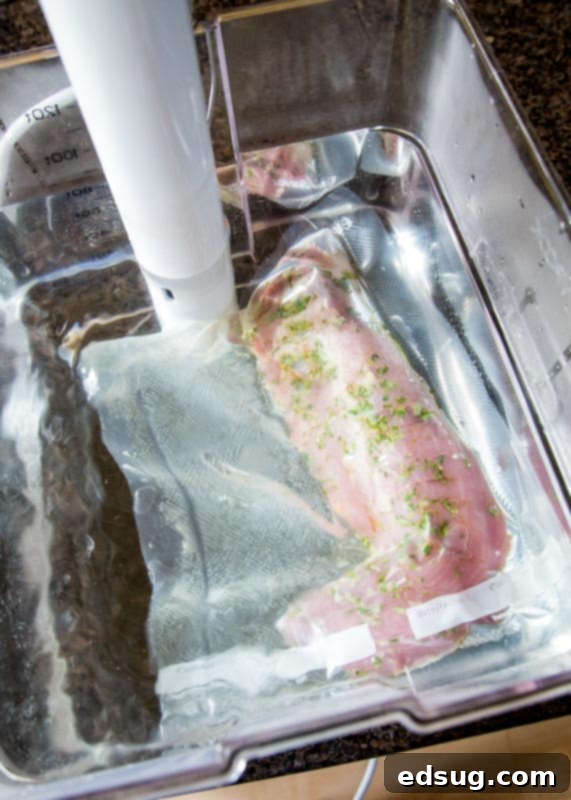
Optimal Sous Vide Pork Tenderloin Cooking Time
For a standard 1-pound pork tenderloin, cooking it for 60 minutes (1 hour) in the 145º F water bath is typically sufficient to bring it to temperature and ensure it is perfectly cooked and tender. However, one of the incredible advantages of sous vide is its flexibility. You can safely leave the pork in the water bath for an extended period, up to 4 hours, without affecting its taste, texture, or doneness. This generous window means you can start your dinner preparation hours in advance, giving you more freedom and less stress when cooking for holidays, dinner parties, or even just busy weeknights. The precise temperature control of the sous vide circulator prevents overcooking, making it a truly ‘set it and forget it’ method within that time frame.
What is the Best Sous Vide Temperature for Pork Tenderloin?
As mentioned, I personally recommend and cook my pork tenderloin at 145º F (63º C). This temperature delivers an incredibly juicy, tender, and delicious result with a slight pink hue in the center, signifying perfect doneness as approved by food safety guidelines. While it’s technically possible to cook pork at a slightly lower temperature (e.g., 140º F) for a longer duration to achieve pasteurization and safety, I find 145º F to be the sweet spot for texture and visual appeal without any worry. It results in pork that is moist and tender without being perceived as “undercooked” by those who might be hesitant about pink pork. A 60-minute cook time at this temperature yields fantastic results every time.
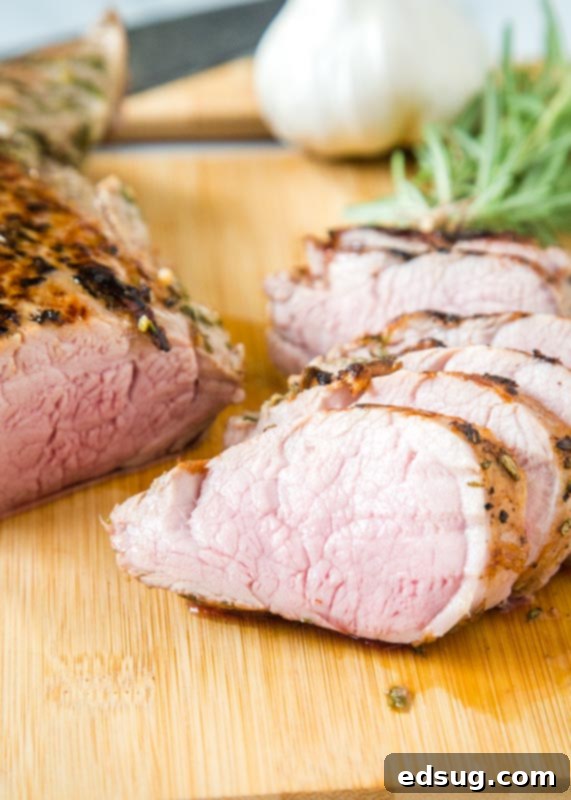
Can You Sous Vide Pork Tenderloin in its Original Packaging?
You often find pre-seasoned and pre-marinated pork tenderloins readily available in the meat department of most grocery stores. This can be a convenient option for an even quicker meal. The key consideration when sous viding meat in its original packaging is the material of the packaging itself. Always check the label to see if the package explicitly states it is “microwave-safe” or “boil-safe.” These labels indicate that the plastic is food-grade and can withstand higher temperatures without leaching harmful chemicals into your food.
If the packaging does not specify that it’s safe for high heat or boiling, it’s always best to err on the side of caution. In this case, simply transfer the pre-seasoned pork tenderloin to a food-grade, zip-top freezer bag or a vacuum-sealable bag before placing it in the sous vide bath. This ensures your meal is not only delicious but also safe.
Sous Vide Frozen Pork Tenderloin: A Time-Saving Trick
Absolutely, yes! This is another fantastic benefit of sous vide cooking. Pork tenderloins are often sold in packs of two, and many home cooks like to use one and freeze the other. If you’ve seasoned and vacuum-sealed a tenderloin before freezing it, you can take it directly from the freezer to the sous vide bath. There’s no need to thaw it in advance!
When cooking from frozen, simply add an additional 45 minutes to 1 hour to the total cook time. This extra time allows the frozen tenderloin to thaw and then come up to the desired cooking temperature within the water bath. This makes meal planning incredibly easy and flexible, as you don’t have to remember to pull the meat out of the freezer hours before you want to cook. It’s a super easy and convenient way to get a delicious meal on the table, even when your plans change last minute.
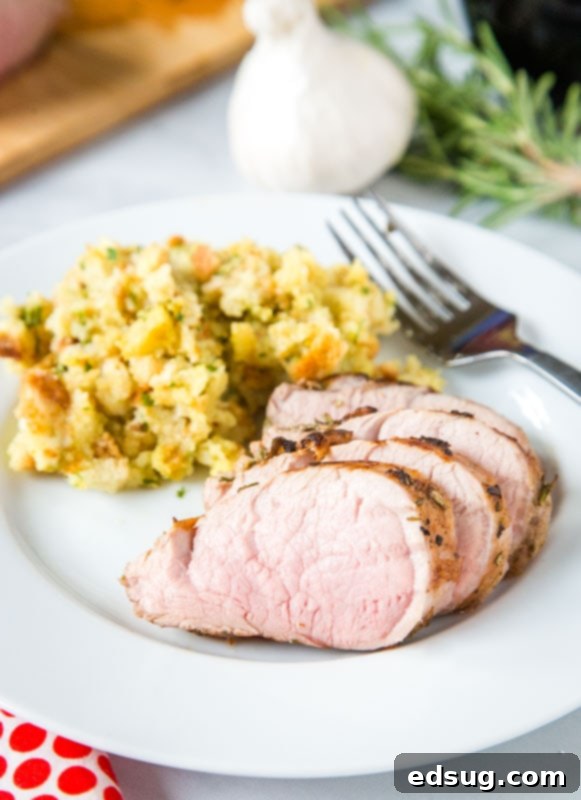
Delicious Side Dishes to Serve with Sous Vide Pork Tenderloin
Pork tenderloin is incredibly versatile and pairs well with a wide variety of side dishes. Its mild flavor allows it to complement both hearty and lighter accompaniments. Here are some fantastic options to serve alongside your perfectly cooked sous vide pork tenderloin:
- Creamy Scalloped Potatoes: The rich, cheesy layers of scalloped potatoes provide a comforting and satisfying contrast to the lean pork.
- Bright Sauteed Asparagus: A quick and easy green vegetable that adds freshness and a slight crunch.
- Garlicky Italian Cheese Pull Apart Bread: A delightful side that’s perfect for soaking up any delicious juices.
- Savory Sauteed Mushrooms: Earthy mushrooms cooked in butter and herbs make a wonderful, umami-rich accompaniment.
- Roasted Root Vegetables: Carrots, parsnips, and potatoes roasted until caramelized bring natural sweetness and a hearty element.
- Creamy Polenta or Risotto: For a more elegant meal, a smooth polenta or a flavorful mushroom risotto is a divine pairing.
- Fresh Green Salad: A simple salad with a light vinaigrette can cut through the richness and provide a refreshing counterpoint.
Pork tenderloin, being a lean cut, is notoriously difficult to cook perfectly in an oven or on a grill without it drying out or becoming tough. The sous vide method completely removes all the guesswork, guaranteeing a tender and juicy result every single time with minimal effort on your part. It’s a method that produces a dish elegant enough to serve to guests for special occasions, yet so simple and hands-off that it’s ideal for a busy weeknight meal.

Recommended Sous Vide Equipment
To embark on your sous vide journey, you’ll need a reliable immersion circulator. I personally use and highly recommend the Joule by Breville Sous Vide. It’s a powerful, accurate, and incredibly reliable device that has consistently delivered excellent results in my kitchen. While I’ve tried other models in the past, the Joule has proven to be durable and accurate, making it a worthwhile investment for any home cook looking to explore the benefits of precision cooking.
More Delicious Pork Dinner Recipes You’ll Love
If you’re a fan of pork, here are some other mouth-watering recipes to add to your rotation:
- Smothered Pork Chops
- Instant Pot Country Style Ribs
- Oven Baked Pork Chops
- Instant Pot Pork Tenderloin
- Crock Pot Pork Roast
- Pork Adobo
- Air Fryer Pork Tenderloin
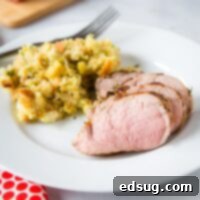
Sous Vide Pork Tenderloin
Rate Recipe
Print Recipe
Ingredients
- 1 pork tenderloin, approximately 1 pound
- 1 teaspoon salt
- 1/2 teaspoon black pepper
- 4 cloves garlic, minced
- 4 springs fresh rosemary, finely chopped
- 2 Tablespoons olive oil
- 1 Tablespoon vegetable or avocado oil
Instructions
-
Preheat your sous vide water bath to 145 degrees F (63°C).
-
Season the pork tenderloin generously on all sides with salt and pepper.
-
In a small bowl, mix together the finely chopped fresh rosemary, minced garlic, and 2 tablespoons of olive oil. Rub this mixture thoroughly over the entire surface of the pork tenderloin.
-
Place the seasoned pork tenderloin into a vacuum-sealable bag. If using a vacuum sealer, remove all air and seal tightly. If using a zip-top bag, employ the water displacement method: slowly lower the bag into the preheated water bath, allowing the water pressure to push the air out. Seal the bag completely just before the opening goes underwater.
-
Once the water bath reaches the target temperature, carefully place the sealed bag of pork into the water, ensuring it is fully submerged for even cooking.
-
Cook for 1 hour. For greater flexibility, the pork can remain in the water bath for up to 4 hours without any negative impact on its texture or doneness. If cooking from frozen, add an additional 45 minutes to 1 hour to the cooking time.
-
Once cooking is complete, carefully remove the pork from the bag. Use paper towels to pat the entire surface of the tenderloin thoroughly dry. This step is essential for achieving a good sear.
-
Heat 1 tablespoon of vegetable or avocado oil in a large skillet over high heat. The oil is hot enough when it begins to shimmer.
-
Carefully place the dried pork tenderloin into the hot pan. Sear for about 30-45 seconds per side, rotating the pork until a beautiful golden-brown crust forms on all surfaces. Avoid over-searing, as this can cook the interior further.
-
Remove the seared pork tenderloin from the pan, slice into medallions, and serve immediately. Enjoy your perfectly tender and flavorful sous vide pork!
Nutrition
Nutrition information is automatically calculated, so should only be used as an approximation.
Additional Info
Like this recipe? Leave a comment below!
I’ve created a fun and engaging community group on Facebook, and I’d be absolutely thrilled for you to join us! It’s a vibrant space where you can
share your favorite recipes, ask culinary questions, and stay updated on all the new and exciting things happening at Dinners, Dishes and Desserts, ensuring you never miss a delicious new recipe!
Be sure to follow me on Instagram and
tag #dinnersdishes so I can see all the wonderful DINNERS, DISHES, AND DESSERTS
recipes YOU make and share!
Don’t miss out on any posts! Be sure to follow me on my social media channels to stay connected:
Facebook | Twitter | Pinterest | Instagram
